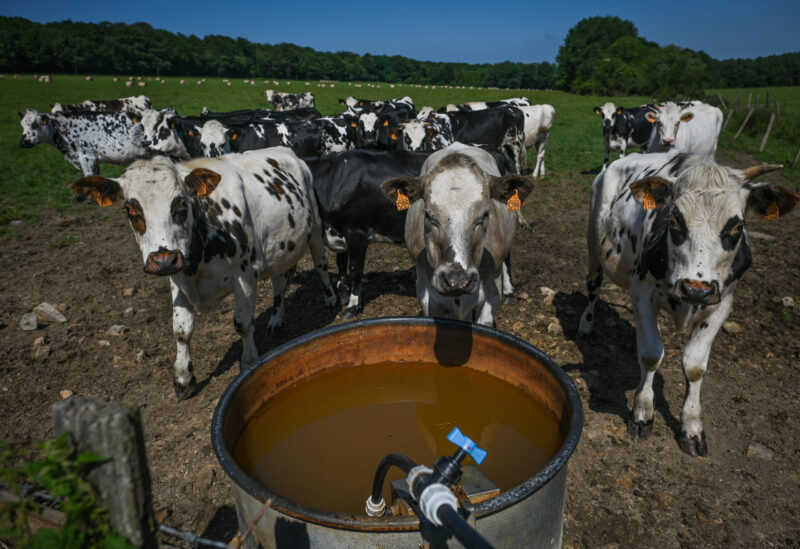Leslie Cordes is vice president of programs at the sustainability nonprofit Ceres.
As global policymakers, nonprofit advocates and industry leaders meet this week in Geneva to turn lofty promises to slash methane emissions into meaningful action, a crucial stakeholder will largely be missing from the table: the private sector.
The aim of the 2024 Global Methane Forum is to build on the Cop26 climate summit, where more than 150 countries pledged to reduce global methane emissions by at least 30% by 2030, as well as other methane commitments made at last year’s Cop28.
But ratcheting up private sector action remains a looming agenda item. Because for all those promises, we aren’t seeing the companies in the sectors that contribute most to humanity’s methane emissions – agriculture and energy – take the ambitious steps needed to fulfill them.
In fact, new findings show the energy industry’s methane emissions didn’t budge last year from a near all-time high. Nor have we seen enough investors step up to drive this needed action in the companies they hold.
Fossil fuel industry under pressure to cut record-high methane emissions
Food companies’ agricultural activities, especially raising livestock, and fossil fuel operations, largely from oil and gas companies, are responsible for nearly equal parts of 75% of human-caused methane emissions worldwide.
Food and energy corporations must confront the escalating material financial risks they face from climate change. Lowering methane emissions is one of the fastest and most cost-effective ways to slow the overheating of our planet in the short term.
There are three key actions companies across both sectors can take to mitigate their main sources of methane pollutants – and in doing so, accelerate the transition to more sustainable and resilient systems for feeding and powering our world.
Disclose plans for reducing emissions
Before they can tackle them, companies need to understand what their methane emissions are, where they come from, and how they can reduce them. These details should be disclosed in their transition plans so that external stakeholders, including investors who use the information to evaluate climate risk in their portfolios, can hold companies accountable for voluntary methane commitments.
More major food companies benchmarked by Ceres in our investor-led Food Emissions 50 initiative are reporting the drivers of their supply chain emissions, but only a few, such as Yum! Brands and Starbucks, have disclosed how they address livestock emissions. Since most of the sector’s methane emissions – and around 12% of global greenhouse gas emissions – stem from livestock, it’s critical that companies include this in their plans.
Oil and gas companies, for their part, should join sector-wide efforts like the United Nations Environment Programme’s Oil and Gas Methane Partnership 2.0, which seeks to improve accuracy and transparency of methane data and track corporate progress. Over 130 businesses globally are participating in this partnership and have committed to report their measurement-based emissions, set a methane reduction target, and submit an implementation plan.
Leverage technology
In both sectors, companies must embrace existing and emerging technologies for the global community to successfully reach its methane reduction goals.
Food companies won’t be able to meet their emissions targets using current agricultural technologies and practices, but livestock emissions could be cut substantially through sustainable changes to farming practices. Companies will have to invest in, and incentivise farmers to adopt, new technologies that are already gaining traction, such as seaweed feed additives for cattle, and other proven and ready-to-deploy methods for curtailing agricultural methane.
To achieve net zero by 2050, methane emissions from fossil fuel operations need to fall by around 75% between 2022 and 2030. That may seem like an enormous task, but oil and gas companies can avoid more than 75% of current emissions using known technology, including replacing methane-emitting equipment with zero-emitting alternatives, with close to 50% of emissions avoidable at no net cost.
Advocate for new policies
Government policies can create new opportunities and mandates that support sector-wide methane action – and companies need to advocate for them. Ahead of Cop27, 800-plus investors representing nearly $42 trillion assets under management signalled just how essential policies are to reaching a net zero economy when they called on governments to radically increase their climate ambition.
Recently, we have seen new policies open important pathways for funding and advancing lower-emissions agricultural solutions, such as when the U.S. Food and Drug Administration streamlined the process for methane-inhibiting feed additives to gain regulatory approval last month. Before and at Cop28, the European Union adopted more stringent regulations, and Canada proposed robust regulations to significantly reduce oil and gas methane emissions.
With the international climate community’s eyes on methane this week, and 2030 rapidly approaching, it’s time to focus on igniting action where the opportunity – and responsibility – for cutting emissions is the greatest. If food and fossil-fuel companies do not clean up their operations, they will not be able to uphold their climate commitments, nor will we meet our global methane goals.
